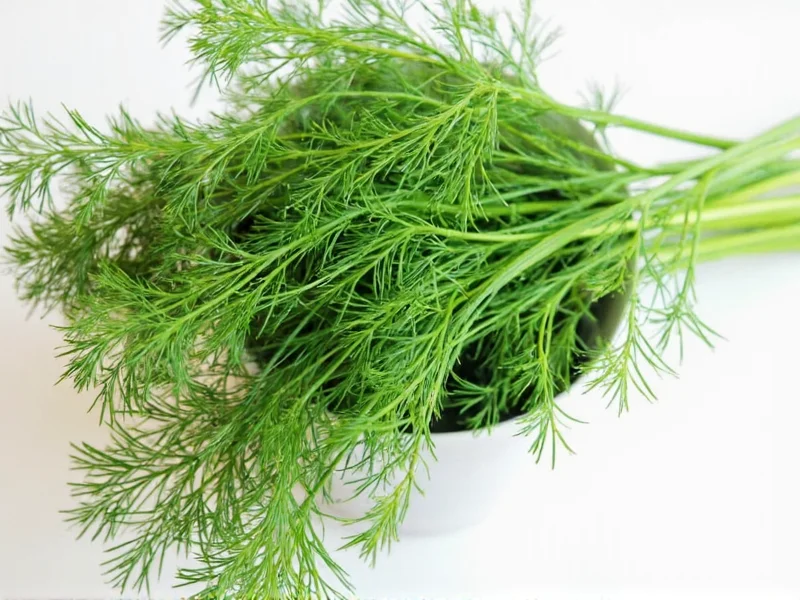Understanding the differences between these two forms of dill is crucial for successful substitution in your cooking. While they come from the same plant (Anethum graveolens), dill seed and dill weed represent different parts with distinct flavor characteristics that affect how they perform in various recipes.
Understanding Dill Seed vs. Dill Weed
Dill seed comes from the mature seed heads of the dill plant, harvested after the plant has flowered. These small, oval seeds have a brownish color and deliver a warm, slightly bitter flavor with pronounced caraway and citrus notes. The flavor is more concentrated and earthy, making it ideal for pickling, breads, and hearty dishes.
Dill weed refers to the fresh or dried feathery leaves and stems of the dill plant. It has a much more delicate, grassy flavor with subtle anise notes. Fresh dill weed offers the brightest flavor, while dried dill weed retains much of its characteristic taste but with less intensity. This makes it perfect for salads, dressings, fish dishes, and other applications where a lighter herb flavor is desired.
Flavor Profile Comparison
| Characteristic | Dill Seed | Dill Weed |
|---|---|---|
| Flavor Intensity | Strong, concentrated | Mild, delicate |
| Primary Notes | Caraway, citrus, earthy | Grassy, anise, fresh |
| Best Used In | Pickling, breads, stews | Salads, dressings, fish |
| Substitution Ratio | 1 tsp seed = 1 tbsp weed | 1 tbsp weed = 1 tsp seed |
| Heat Tolerance | Excellent (adds depth when cooked) | Fair (best added at end of cooking) |
When Substitution Works Best
Successful dill seed substitution depends on your recipe type and desired flavor outcome. For pickling recipes and canning applications, dill seed often works better than dill weed anyway, as its stronger flavor holds up well during the preservation process. In fact, many traditional pickling recipes specifically call for dill seed rather than weed.
For cooked dishes like soups, stews, and braises, substituting dill seed for dill weed works reasonably well, especially if you're aiming for that characteristic dill flavor without the fresh herb notes. The heat of cooking helps mellow the seed's stronger flavor, making it more compatible with what you'd expect from dill weed.
However, for fresh applications like salads, dressings, dips, and as a garnish, substituting dill seed for dill weed generally doesn't work well. The strong, pungent flavor of the seed will overpower delicate dishes, and you'll miss the fresh, grassy notes that dill weed provides. In these cases, consider alternative substitutes like fresh parsley, tarragon, or fennel fronds instead.
Precise Substitution Guidelines
When substituting dill seed for dill weed, follow these specific measurements for best results:
- For every 1 tablespoon of fresh dill weed, use 1 teaspoon of dill seed
- For every 1 tablespoon of dried dill weed, use ¾ teaspoon of dill seed
- In pickling recipes, you can use equal parts dill seed where dill weed is called for
Always add dill seed early in the cooking process to allow its flavors to mellow and integrate, while dill weed (especially fresh) should be added near the end of cooking to preserve its delicate flavor. When substituting, start with less than the recommended amount, taste your dish, and adjust as needed—remember that you can always add more, but you can't remove excess.
Storage Considerations for Dill Substitutes
Proper storage affects how well your dill substitutes will perform. Dill seed maintains its potency for 3-4 years when stored in an airtight container away from light and heat. Dried dill weed keeps well for 1-2 years under similar conditions, while fresh dill weed lasts only 7-10 days in the refrigerator.
If you frequently find yourself needing dill weed but only have dill seed, consider growing your own dill plant. It's relatively easy to grow and provides a continuous supply of fresh dill weed throughout the growing season. Alternatively, freeze fresh dill weed in ice cube trays with water or oil for longer-term storage that preserves more flavor than dried dill weed.
Alternative Substitutes When Dill Seed Isn't Ideal
When substituting dill seed for dill weed isn't appropriate for your recipe, consider these alternatives:
- Fresh parsley with a pinch of fennel seeds: Works well in salads and as garnish
- Tarragon: Provides a similar anise note, though stronger; use at half the amount
- Fennel fronds: Closest fresh substitute with similar appearance and mild anise flavor
- Dill pickle juice: Adds dill flavor to dressings and marinades
For recipes specifically requiring the distinctive flavor of dill (like tzatziki or Scandinavian gravlax), these substitutes won't provide the authentic taste, so it's worth seeking out actual dill weed if possible.
Practical Application Examples
Pickling cucumbers: Dill seed actually works better than dill weed in most pickling recipes. Use 1 teaspoon of dill seed per jar instead of the fresh dill weed traditionally placed at the bottom.
Potato salad: Substituting dill seed for dill weed here isn't recommended as the strong seed flavor will overpower the dish. Instead, use fresh parsley with a few chopped fennel fronds for a similar visual effect and mild flavor.
Cucumber soup: For cold cucumber soup that relies on fresh dill flavor, dill seed substitution won't work well. Consider using fresh chives or a small amount of fresh tarragon instead.
Dill bread or crackers: Dill seed is actually preferred over dill weed in baked goods as its flavor holds up better during baking. Use the full amount of dill seed called for without reduction.











 浙公网安备
33010002000092号
浙公网安备
33010002000092号 浙B2-20120091-4
浙B2-20120091-4